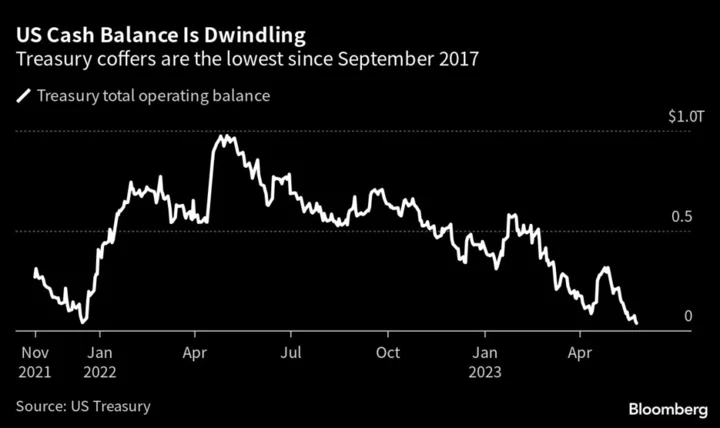Bond traders look set to pivot from worrying the US wouldn’t raise its debt limit to fretting about what the increase means for money markets.
The concern is that with a tentative deal pending, the Treasury will soon replenish its cash balance by selling more than $1 trillion of bills through the end of the third quarter, according to recent estimates. The US cash stockpile currently sits at $39 billion, the lowest since 2017.
A deluge is likely to suck a significant amount of liquidity out of financial markets. That could add pressure given the Federal Reserve has been raising interest rates and shrinking its balance sheet.
A $1 Trillion T-Bill Deluge Is Painful Risk of a Debt-Limit Deal
With the Treasury competing with banks for cash, lenders may see their own short-term funding rates rise, forcing them to boost the borrowing costs they impose on businesses and households.
Bank of America Corp. analysts have estimated that would have the same economic impact as a quarter-point interest rate hike, a squeeze which would come as traders are already predicting the Fed could lift its benchmark another 25 basis-point rate rise by July.
The result is that while yields on short-term Treasuries may drop on the relief of an agreement, the fall would be limited as investors try to assess what comes next.
“There will be a knee-jerk reaction in T-bills as that area of the market has borne the burden of uncertainty,” Kevin Flanagan, head of fixed income strategy at Wisdomtree Investments, said on Friday. “So yields come down from their highs, but because the Treasury will increase issuance, there is a floor in yields for that market.”
Biden, McCarthy Forge Debt-Limit Deal in Bid to Avert US Default
Cash Stockpile
The debt limit dispute has generated tensions in markets, with investors demanding higher yields on securities set to be repaid shortly. Rates on instruments due early June topped 7% at one stage last week. The price on credit default swaps — derivatives that allow investors to insure against non-payment — peaked well above levels seen in the 2011 debt limit episode.
The US cash stockpile, or the Treasury General Account, will soar to $550 billion as of the end of June and hit $600 billion three months later, according to the department’s estimates at the beginning of the month.
Efrain Tejeda, a short-term interest rate strategist at Morgan Stanley, forecasts T-bill issuance will amount to $730 billion over the next three months and about $1.25 trillion over June through December. During the 2017-2018 debt-ceiling episode, the Treasury ended up issuing $500 billion of bills in roughly six weeks.
Repo Puzzle
An important piece of the puzzle is the Fed’s reverse repurchase agreement facility — dubbed the RRP — which is where money-market funds park cash with the central bank overnight at a rate of just over 5%.
That program — currently over $2 trillion — is also a liability at the Fed. If the Treasury account increases, but RRPs drop, then the drain on bank reserves would be lower.
Matt King, a strategist at Citigroup Inc., has warned money funds’ tendency to keep cash in RRPs will most likely persist, which could mean a sizable drain in reserves when the Treasury’s cash jumps.

